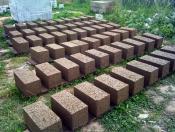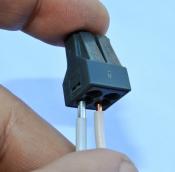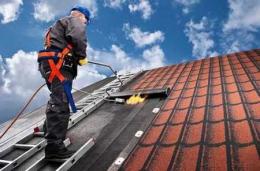Search
Login
Recommended
Rolled roofing materials, how to choose the right
Despite the wide variety of roofing materials, both modern and traditionally used, soft roofing stably holds its position, which even the latest fashion trends are unable to undermine. The reasons for the popularity lie in the advantages that no other roofing material has, namely, the possibility of laying in any direction. Of course, in order for the roof to possess the proper qualities, roofing materials should be chosen; soft roofs in accordance with their intended use.
Content:
- Scope of rolled roofing materials
- Rolled roofing materials and their varieties
- What types of roll coatings are used in today's construction video
- Roll roofing and its advantages video
- Baseless roofing materials and their features
- Technonikol - market leader in soft roofing materials video
- What are the benefits of rolled roofs?
Scope of rolled roofing materials
The choice of roofing material should be made based on its requirements for results, i.e. will have to analyze the operational characteristics of the materials, protective and technical, to correlate them with the appearance. Although the attractiveness of the roof is a thing important enough for the overall design of the structure, but first of all it is recommended to study the technical properties.

To begin with, roll roofing is used for roofs with a slope of 10 to 30 degrees. You can use a soft roof for gable and single-pitch roofs.
Typical soft roof applications:
- complex roofs for large-scale construction,
- roof shelter of a flat design,
- the creation of roofs over industrial facilities and civil structures.
In principle, it is possible to use a rolled roof during the construction of a country house and a presentable cottage, it will be able to provide the proper level of attractiveness and protect any construction from rain or snow.
As a positive point, it should be noted that in the event of a leak, it is not necessary to completely change the entire coating - it will be enough to detect a leaky place and cover it with a fused patch.
High demand for surfaced materials today is provided by their rather aesthetic appearance and service life, measured by a quarter of a century.
Rolled roofing materials and their varieties
All soft roll materials are conventionally divided into several types, each of them is characterized by certain technical features regarding their structure, method of installation and subsequent operation.
The category of roll materials includes materials, the laying process of which involves the use of bitumen or polymer mastics, used both in hot and in cold form.

Modern rolled materials can also have an adhesive layer that allows to simplify the installation process as much as possible: it will be enough to remove the protective film and connect the strip of material, the joints at the same time are quite durable.
Surfaced polymer roofing materials require the use of auxiliary equipment: a gas cylinder with a burner.
Soft roofs are classified in accordance with GOST 3054797, which contains information about the parameters of this type of coating.
What types of roll coatings are used in today's construction
Depending on the structure of the base, it is possible to distinguish species having a base and created without it.

Types made on the basis of, in turn, are divided by the type of basis, which can be used as:
- cardboard or asbestos,
- polymer material or fiberglass.
Depending on the coating composition, there are:
- bituminous roofing materials,
- bitumen-polymer,
- polymer.
If you take into account the used protective layer, then you can select materials with sprinkling, film or foil.

Surfaced roof, judging by the material of manufacture and the structure of the sheet, is a bitumen-polymer material on a synthetic basis, which can be used fiberglass, fiberglass or polyester.
On both sides, the reinforcing layer is covered with layers of bitumen-polymer material, in turn they are protected by low-melting polyethylene film, and the front layer is covered with stone filling.

Modern materials have significant differences with their predecessors, roofing material and rubemast, however, the production of cardboard-based materials does not stop and they are in stable demand.
To understand the quality of materials in more detail, it is desirable to study the technology of their production:
Roll roofing and its advantages
Roll roofing has several significant advantages:
- light weight of rolls makes it easy to carry out transportation,
- installation is quick, special skill and skills do not require work,
- the resulting surface is durable and flexible, provides sound insulation of the roof and reliably protects the house from the penetration of rain,
- it’s green
- it keeps warm well
- retains its original properties after exposure to sunlight and temperature extremes.
If in the old days bituminous roofing materials, for example roofing material, were made on a cardboard basis and did not differ by a particularly long service life, today today fiberglass is usually used as the basis, the material is not susceptible to decay.

A more problematic moment was the tendency to age the bitumen roofing material, which is used as a base coating. The issue was resolved by introducing polymer modifiers into the composition of the bitumen coating, which, incidentally, are also considered environmentally friendly substances.
Sufficiently high performance characteristics contribute to the fact that rolled roofing materials for the roof, the price of which, by the way, is quite affordable, are massively used in the construction of residential and technical facilities.

The cheapest and therefore affordable roofing material for any budget is roofing material, it is made on a cardboard base impregnated with bitumen. As a base coating, a composition of bitumen with mineral fillers is used, the front side of the material is covered with a fine mineral powder. Serves ruberoid, made by modern technologies, about 10 years.
The difference between rubemast and roofing material is the presence on the underside of the canvas of a bitumen binder layer.
Similar materials on a better, fiberglass basis:
- glass melt,
- glass roberoid,
- stekloizolol.
A more modern version of rolled roofing materials, with sufficiently high operational characteristics, is the so-called euroroofing material, which is a polymer-bitumen roofing membrane.

The most wear-resistant and easy to install - membrane coating, it can be called the youngest in this line of materials.
Self-adhesive coatings are easy to install, before laying the next strip, it is enough to remove the protective layer from the wrong surface of the material, then lay it on the roof surface and roll it out. A sufficient condition for the successful completion of the connecting process will be a high ambient temperature, i.e. It is advisable to do the work in the summer, on a sunny day. The limiting point in the use of coatings of this type is the rather high cost of the material.
Let's watch a video about modern roofing materials:
Baseless roofing materials and their features
Among the advantages of baseless materials, the absence of a rigid base is noted in them, at first glance an insignificant fact, in fact, it allows the installation of the material on surfaces with great deformation, which is sometimes very important. The technologies for manufacturing baseless materials allow us to claim that they are environmentally friendly.

Isol
For the manufacture of Isol use recycled rubber, previously subjected to its devulcanization in a bitumen medium. Further, its composition is enriched with fibrous filling fragments, asbestos fibers and other additives can be used for their manufacture.
Thus obtained material is elastic and resistant to biological effects. Deforming loads do not lead to a violation of the integrity of its structure, even if processes occur at low temperatures. The water-repellent characteristics of the material are high, temperature changes do not have a negative effect on them, the scope of Isola is the arrangement of a waterproofing layer.
Brizol
The second popular baseless roll coating is Brizol. It is made from shredded tires, plasticizers, fillers and oil bitumen with various degrees of viscosity are also used in production.

Modern manufacturing technologies make it possible to obtain a coating characterized by excellent resistance to aggressive environments, even 20% hydrochloric or 40% sulfuric acid will not be able to cause destruction of the material, high temperatures will not significantly affect its structure, brizol can withstand heating to temperatures above 60 degrees.
As a positive point, the ability to retain not only moisture but also a gaseous medium should be noted.
Brizole comes on sale in the form of a rolled material, its inner surface is treated with fine powder before packaging to prevent sticking.
GMP
Polyisobutylene-based material is made. The material has high quality characteristics and has a long service life. There are three grades of material on sale, its scope is sheltering flat roofs and equipping hydro and vapor barrier systems for roof construction.
Film materials are also manufactured using baseless technologies; polyamide and polyethylene are used as production materials. Attractive features of these products are low weight and full moisture resistance. In addition, the materials are resistant to temperature extremes. However, coatings have significant drawbacks: they quickly collapse when exposed to direct sunlight, so the scope is limited, they do not install on open surfaces.
Technonikol - market leader in soft roofing materials

Technonikol has been manufacturing roofing materials for more than 20 years, scientists and engineers are working on the development of new materials, production workshops have the latest equipment, all lines are equipped with automated control systems. Manufacturing technology involves monitoring and computer analysis of the quality of products.

All products manufactured by the company have European certification, some of which are even included in liability insurance programs.
Technonikol produces not only roofing roll materials, but also waterproofing, heat-insulating, sealants and foams, mastics and primers. Numerous brands of premium products and standard classes have excellent quality characteristics of strength, deposited or glued to mastic, they are not prone to fire, provide reliable protection of roofs and foundations from moisture and last at least 25-30 years.
On the video you can see how the soft roof is laid:
What are the benefits of rolled roofs?
In the market of modern roofing materials, soft roof rolls are the most affordable in price, nevertheless they have high quality characteristics.
The next indisputable advantage is the low specific weight of materials, the ability to use them for the construction of new and repair of old roofs, not differing in the strength of the rafter system.

The costs of installation and transportation are not high, it is possible to carry out loading operations without the use of special equipment.
An attractive point for consumers is the lack of need for constant care throughout the entire operational period. Given the good performance of noise insulation and waterproofing materials, according to consumers, can be classified as ideal.





